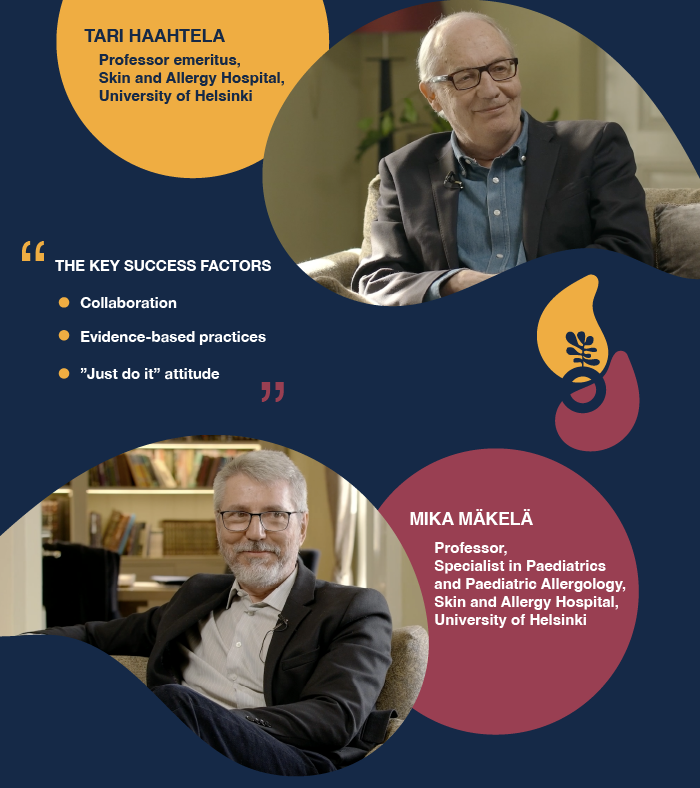EPISODE 1
Finnish Asthma and
Allergy Programmes
- history and overview
Introduction
Finland has achieved notable success in improving asthma and allergy care in recent decades. Much of the achieved success can be attributed to the two nationwide initiatives known collectively as The Finnish Asthma and Allergy Programmes. These groundbreaking campaigns were launched with the ambitious goal of reducing the burden of asthma and allergies for both patients and society. How were these programmes started and what can be learnt from the Finnish experience? Follow this content series and find out ways to improve asthma and allergy care in your clinical practice!
In the first episode of the content series, Professor Emeritus Tari Haahtela and Professor Mika Mäkelä, two physicians integral to the programmes, share their first-hand experiences on how the programmes were initiated and transformed asthma and allergy care in Finland. Watch the video and read more in the text below!
The Finnish Asthma and Allergy Programmes – history and overview
The global prevalence of asthma and allergic diseases has significantly increased over the past decades. This upward trend can be attributed at least in part to the changing environment in which we live – urbanisation has led to diminished contact with nature, potentially leading to microbial imbalance and immune dysfunction. (1) The growing burden of asthma and allergies required action: something needed to be done to tackle this epidemic.
Professor Emeritus Tari Haahtela and Professor Mika Mäkelä described how it all started: “Finland has been actively involved in asthma research right from the beginning. Clinical interventions showed that the inhaled corticosteroids changed the outcome of the patients quite remarkably. We thought that we should implement these ideas for the whole country and for all asthma patients. That is why we started the first asthma programme already in 1994.”

The Finnish Asthma Programme (1994–2004) was a success story: asthma-related hospitalisations halved, disability pensions decreased by over two-thirds, and costs to society reduced, despite a growing number of patients with asthma. (2)
To address the escalating allergy epidemic, the initial program was expanded to cover allergies as well. The Finnish Allergy Programme (2008–2018) carried forward the successes of the first programme, resulting in significant decreases in food allergy diets and smoking, and an increased awareness of anaphylaxis. (1)
Driving success: The power of goal setting and evidence-based decision making
Professors Haahtela and Mäkelä highlighted the crucial role of scientific research in the Asthma and Allergy Programmes. The programmes, recommendations, and guidelines were all based on the latest scientific evidence from clinical studies. The programmes were also driven by well-defined and measurable goals, ensuring a tangible means to assess their achievements.
Additionally, it was considered imperative to involve the stakeholders from the beginning, ranging from government officials to doctors, pharmacists, nurses, and patient organisations. Strong collaboration, evidence-based decision making, and a determined "can-do" attitude were the driving forces that propelled progress forward.
How can the learnings from Finnish experience be implemented locally?
The achievements of the Asthma and Allergy Programmes have attained international attention. The initiatives have been cited in numerous scientific publications over the years and were notably highlighted in The Lancet journal in 2019. (3) A lot can be learned and applied from the Finnish experience, while recognising the importance of tailoring such programmes and initiatives to address specific local needs and align with a distinctive healthcare landscape.
The programmes have shown that with focused actions the burden of asthma and allergies can be reduced. Importantly, local impact can be achieved by individual healthcare professionals in their respective units and clinical practice, without necessarily relying on national programs.
This educational series aims to convey the knowledge and outcomes derived from the Finnish experience, empowering healthcare professionals in the management and prevention of asthma and allergic diseases in their everyday clinical practice. Discover the key elements behind the success and how the changes were implemented across the healthcare system. Follow the series to learn more!
You might be interested in these:
References
1. Haahtela T, Jantunen J, Saarinen K, Tommila E, Valovirta E, Vasankari T, et al. Managing the allergy and asthma epidemic in 2020s—Lessons from the Finnish experience. Allergy. 2022;77(8):2367–80.
3. Burki TK. Asthma control: learning from Finland’s success. Lancet Respir Med. 2019;7(3):207–8.
RESP-1483a 05/2023